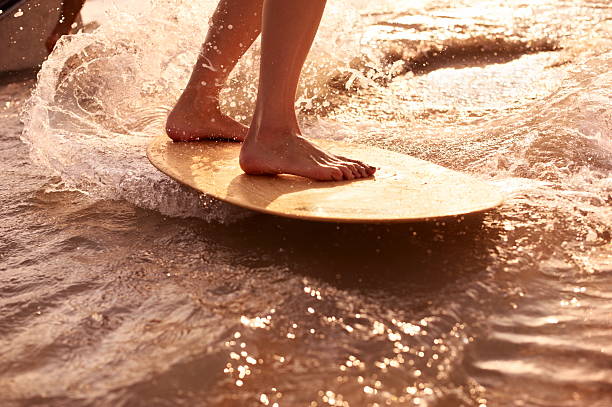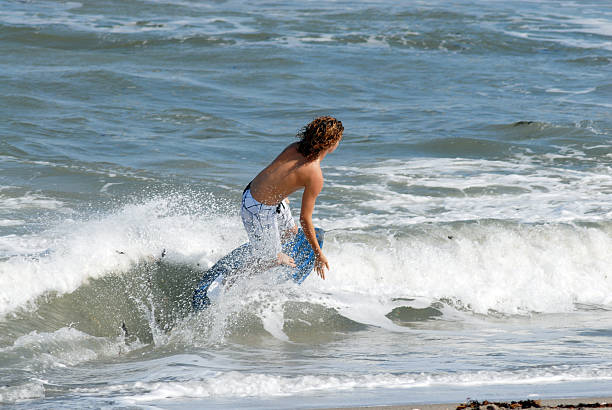When lifeguards at Laguna Beach used thin pieces of wood to slide along the flat water next to the sand, skimboarding as a sport was invented in the late 1920s.
The once-fun beach activity has now developed into a rather well-liked action sport at any beach location with the appropriate conditions. The world’s top skimboarders even compete in a professional league, traveling to some of the world’s top skimboarding beaches to skim and compete.
You can learn to skimboard quickly, though, if you get the right skimboard for you, find a good location, and master some fundamental skills.
Table of Contents
How to Find the Right Board and Location
Buy a Small, Flat, Wooden Board If You’re Mostly Going to Sand Skim.
If you’re just learning how to skimboard, you should probably start out by doing it on the sand rather than the water. The majority of wooden boards have a flat design, which is all that is necessary for sand skiing. Additionally, foam boards are typically more expensive than wooden boards, making wooden boards the better option for skimboarders looking to save money.
• A wooden skimboard usually costs around $100.
• The majority of sporting goods stores and numerous big-box stores sell wooden skimboards.
Opt for a Curved Foam Board to Go Skimming on Water.
You should purchase a skimboard that isn’t as heavy as your sand skimming board once you’ve mastered skimming on the sand and want to try it on water. Compared to wooden boards, foam boards are much lighter, making them the best choice for skimming across the water. Additionally, they are frequently made with a curved shape that makes it simpler for the skimmer to ride alongside breaking waves.
Foam skimboards typically cost around $200, but some can cost as much as $600.
Find a Flat Beach Along the Coast to Skimboard On.
Any beach with flat, smooth sand is the ideal location to go sand skiing. The best shoreline for skimming on the water is one with a strong shore break, which means it generates large waves you can ride all the way back to shore.
• Going to a beach with a steep slope may be preferable if you want to concentrate primarily on wave skimming rather than sand skimming.
• San Diego, England, and Florida are some of the locations of some of the busier beaches for skimming.
Make Sure You’re Able to Run and Jump Without Any Physical Issues.
Skimboarding is a physically demanding sport; if you’re not in shape, you could hurt yourself. Try skimboarding only if you are confident that you can ride a board, run in short bursts, and fall a few times while learning.
While you’re learning to skimboard, keep your back and leg muscles warm, limber, and strong to prevent injury.

How to Master the Basics
Lean Forward and Hold Your Board About 6 Inches (15 Cm) above the Sand.
Both sand skimming and wave skimming begin from this position. If you are right-handed, stand with the water on your left side, and vice versa.
• Put one hand on the back tail and one hand on the side rail of the skimboard while holding it in your hands.
• Hold the board parallel to the ground. When skimboarding, one of the most frequent mistakes is to point the board upwards before throwing it, which will make the skim much slower.
Throw the Board Out in Front of You When the Sand is Wet.
The best conditions for throwing the board are when there is a thin layer of water between 0.25 inches (0.64 cm) and 0.5 inches (1.3 cm) high on the sand. When sand skiing, toss the board just as a wave is being sucked back into the water. Throw it just before a wave arrives if you’re skimming the water.
• To give yourself a longer ride, make sure the board is thrown parallel to the shoreline.
• In order to gain more speed, you can also choose to run ahead of throwing the board. If you can throw the board far enough, it is not strictly necessary to do this.
• When you first start out, throw the board a few times from the starting position to get the hang of it and determine how hard you should throw it.
Run onto the Board Rather Than Jumping onto It After You Throw It.
A moving skimboard will cause you to faceplant if you jump or hop onto it. Instead, maintain a steady pace as you run up to and alongside the board. Put your back foot behind the middle of the board and your front foot just slightly beyond it.
• By using this technique, you can prevent the board from losing any speed as you climb on it (in contrast, if you jump on it, the board is forced to break the surface tension of the water and stops skimming).
• Prior to jumping onto your skimboard, try to take about three running steps.
• When getting on the board, do not forcefully push off with your first foot as this will cause the board to accelerate and fly away from you.
• When you first try to run onto the board, be sure to wear a helmet in case you fail and fall off. Although learning to run onto the board without falling will be challenging, with enough practice, you will be able to master this move!
Keep Your Knees Bent and Your Weight Centered on the Board.
To maintain balance and avoid falling off your skimboard, this is the position to adopt. If you’re sand skiing, exert a little more force with your front foot. If you’re skimming over the water, increase the pressure on your back foot as soon as the board makes contact with the water to prevent the front of the board from catching on it.
• Another effective method for maintaining balance while skimming is to keep your stance low on the skimboard.
• In addition to being a crucial part of skimboarding, your knees are also one of the body parts that are most vulnerable to injury. If your knees begin to ache, stop skimboarding right away to prevent further injury.
Maintain Your Balance until the Board Stops Or Shift Your Weight to Turn.
Skimming is primarily about maintaining control of the board until it comes to a complete stop, whether you’re skimming on sand or water. Simply shift your weight slightly to the side you want to be turning towards if you want to change directions.
Generally speaking, if you stick to sand skimming, you won’t need to turn very much. But the majority of tricks and riding waves require turning.

How to Learn Popular Tricks
Skim onto a Breaking Wave to Ride It.
When the wave starts to break, throw your board down and start skimming toward it from a side angle. Use your back foot to turn the board once you’re on the wave’s crest so that you’re facing the shore. Ride the wave back to land after that.
To aid in maintaining your balance when you are at the base of the wave, bend your knees.
Try a 180-degree Turn to Add a More Complex Trick to Your Repertoire.
Rotate your hips in the desired direction to complete a 180-degree turn. Next, swing your back leg in the same direction as the direction your hips were turned, keeping both feet firmly planted on the board. And finally, keep rotating your hips until you’re facing the other way.
• Don’t attempt it until you’ve mastered turning on a skimboard because, despite how simple it sounds, it’s a little more difficult to physically execute.
• Once you can turn your skimboard 180 degrees, try spinning it 360 degrees to make a turn!
Jump and Spin above the Skimboard to Perform a Body Aerial.
Another well-liked trick that most skimboard beginners can pick up with a little practice is body aerials. When you’re skiing at top speed, leap off the board with both feet and spin once you’re airborne. Land back on the skimboard while keeping your balance in order to complete the trick.
Even if you can only jump and spin above your skimboard, it’s still quite impressive, even though the full trick involves landing back on the board.
Tips and Warnings
• If there isn’t a beach nearby, you can skimboard in shallow rivers or streams.
• Consider purchasing a top-of-the-line board made of the best fiberglass/carbon fiber if you’re serious about skimming waves. You can put your money to the best long-term use with this.
• Although they are not advised for beginners, traction pads can help you keep from falling off your board. A permanent rubber pad that you stick to the deck called a “traction pad” enables you to maintain your balance without falling.
• When skimboarding for the first time, stay out of deep water to lower your risk of drowning. Start by practicing sand drops and fundamental sand skimming.
• When you’re not at ease, don’t skimboard in those circumstances. Avoid the waves, for instance, if they appear to be too large or strong for you.
Final Thought: Keep Practice
These are the basics of how to skimboard.
You will quickly become an expert skimmer if you continue to practice these movements and consider these skimboard tips.
Once you have these down pat, it’s time to pick up a few quick tips and advance to more sophisticated methods.

Comments are closed, but trackbacks and pingbacks are open.